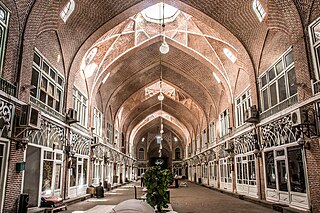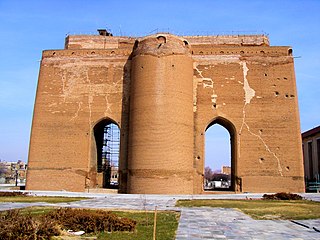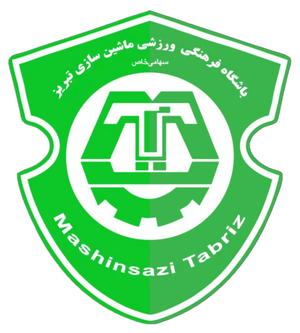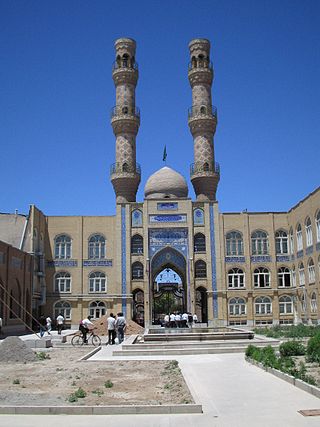See also
This article related to a river in Iran is a stub. You can help Wikipedia by expanding it. |
| Mehraneh roud | |
|---|---|
| Location | |
| Country | Iran |
| State | East Azerbaijan |
| City | Tabriz |
| Physical characteristics | |
| Source | |
| • location | East Azerbaijan, Iran |
| Length | 25 km (16 mi) |
Mehraneh roud is a river in Tabriz, crossing through the middle of Tabriz. It starts in the Sahand mountains.

Tabriz is a city in the Central District of Tabriz County, East Azerbaijan province, in northwestern Iran. It is the sixth-most-populous city in Iran.

Azerbaijan or Azarbaijan, also known as Iranian Azerbaijan, is a historical region in northwestern Iran that borders Iraq and Turkey to the west, the Nakhchivan Autonomous Republic, Armenia, and the Republic of Azerbaijan to the north.

Howard Conklin Baskerville was an American missionary teacher. His life ambition was to become a pastor. He worked as a teacher employed by the American missionaries at the American Memorial School in Tabriz, a Presbyterian mission school, and was killed during the Persian constitutional revolution in an attempt to break the siege of Tabriz. He is often referred to as the "American Lafayette of Iran" and the "American Martyr of the Iranian Constitutional Movement".

The Bazaar of Tabriz is a historical market situated in the city center of Tabriz, Iran. It is one of the oldest bazaars in the Middle East and the largest covered bazaar in the world. It is one of Iran's UNESCO World Heritage Sites.

Arg of Tabriz, is the remnants of a large acropolis fortification and city wall in downtown Tabriz, Iran. Its structure is visible from far distances in downtown Tabriz, if not blocked by the newly erected highrise buildings.

A Tabriz rug/carpet is a type in the general category of Persian carpets from the city of Tabriz, the capital city of East Azarbaijan Province in north west of Iran. It is one of the oldest rug weaving centers and makes a huge diversity of types of carpets. The range starts at Bazaar quality of 24 raj and on up to the incredibly fine 110 raj. Raj is the unit of knot density. It shows the rigidity of the rug which based on the number of strings used for the foundation of the rug. Strings materials are usually made of cotton or silk which is used for very fine rugs.

The Blue Mosque is a historic mosque in Tabriz, Iran. The mosque and some other public buildings were constructed in 1465 upon the order of Jahan Shah, the ruler of Kara Koyunlu.

Sa'at Tower also known as Tabriz Municipality Palace is building in Tabriz which is used as the city hall and main office of the municipal government of Tabriz, East Azarbaijan Province, Iran. Saat tower or Saat in brief, as it briefed by locals in Tabriz, is a building with a hall, a tower with clock, and a small garden in Southwestern side of the building. A circular pool with fountains is located in the middle of the garden.

Tabriz Shahid Madani International Airport is an airport that serves Tabriz, Iran. It is the primary airport of Tabriz. The runway of the airport is also used by Tactical Air Base 2 of the Islamic Republic of Iran Air Force.

Eynali is a mountain range in north of Tabriz, Iran. The range has a couple of peaks including Eynali (1800 m), Halileh (1850 m), Pakeh-chin (1945 m), Bahlul (1985 m) and the highest one Dand (2378 m). It has red soil and Eynali peak and Dand are visible from almost everywhere in Tabriz. There is a tomb at top of the mountain which is believed to be the grave of two clerics which the mountain's name is related to them. There is a belief among people that originally the building was a Zoroasterian temple or a Church that the shrine name to is a cover to saving the structure from destruction during Muslims invasion. A paved road connects the base in Northern highway of Tabriz to the Eynali peak. The paved road is only open for pedestrians. Nowadays the Eynali peak is a daily hiking destination for many residents of Tabriz. In early 2000s like many of other mountains in vicinity of big Iranian cities couple of unknown Iranian victims of Iran-Iraq war's are buried in top of the mountain behind the shrine as memories of the war. The mountain is also used by telecommunication companies and TV stations to rely their waves. Behind this the city council of Tabriz is trying to make an artificial forest at the hillsides of Eynali as northern green belt of Tabriz.
Safīna-yi Tabrīz is an important encyclopedic manuscript from 14th century Ilkhanid Iran compiled by Abu'l Majd Muhammad ibn Mas'ud Tabrizi between 1321 and 1323.

The Sāheb ol Amr Mosque or King Tahmasp Mosque is a mosque located on the east side of Saaheb Aabaad square in Tabriz, Iran. The mosque was initially built in 1636 and has a history of destruction and repair. The name Sāheb ol Amr is one of the titles of the last Twelver Shī‘ah Imām.

Machine Sazi Tabriz Football Club more commonly known as Machine Sazi was an Iranian professional football club based in Tabriz, East Azarbaijan, Iran competing in the Azadegan League.

The Jāmeh Mosque is a large, congregational mosque (Jāmeh) in Tabrīz city, within the East Azerbaijan Province of Iran. It is located in the Bazaar suburb of Tabriz next to the Grand Bazaar of Tabriz and the Constitutional House of Tabriz.

Saint Mary Church, Holy Mother of God Church or Surp Mariam Asdvadzadzin Church is an Armenian Apostolic church in Tabriz, East Azerbaijan Province, Iran completed in 1785. It is the largest and oldest Christian church in Tabriz and a notable centre for Armenian national and religious ceremonies held by the Armenian community of Tabriz.

The Tabriz Metro is a rapid transit system serving the city of Tabriz, Iran. The first phase opened on 28 August 2015 with 7 km length and 6 stations. There is also one regional commuter line planned to Sahand.

The Russian occupation of Tabriz lasted from 30 April 1909 until 28 February 1918, with a brief interruption during 6–31 January 1915. The city of Tabriz was the second city of Qajar Persia at the time, the capital of the region of Azerbaijan, and the traditional residence of the Qajar Crown Prince.

Haidarzadeh’s house is a historical mansion situated in Maghsoudieh suburb of Tabriz, Iran, on the south side of Tabriz Municipality building. There is no document showing the date of construction of this historical house, but studies revealed that the house was constructed about 1870 by Haji Habib Lak. The house was registered in the list of National Remains of the Country in 1999 under the number 2524. It covers an area of 900 square meters and has two floors. The house has two interior and exterior yards which are separated by the house.

The former Consulate-General of the United States, Tabriz was a diplomatic and political venue in Tabriz that operated under the auspices of the US Embassy in Tehran. This consulate was opened in 1906 and was active until the capture of the US Embassy in Tehran and the severance of Iran-US relations.